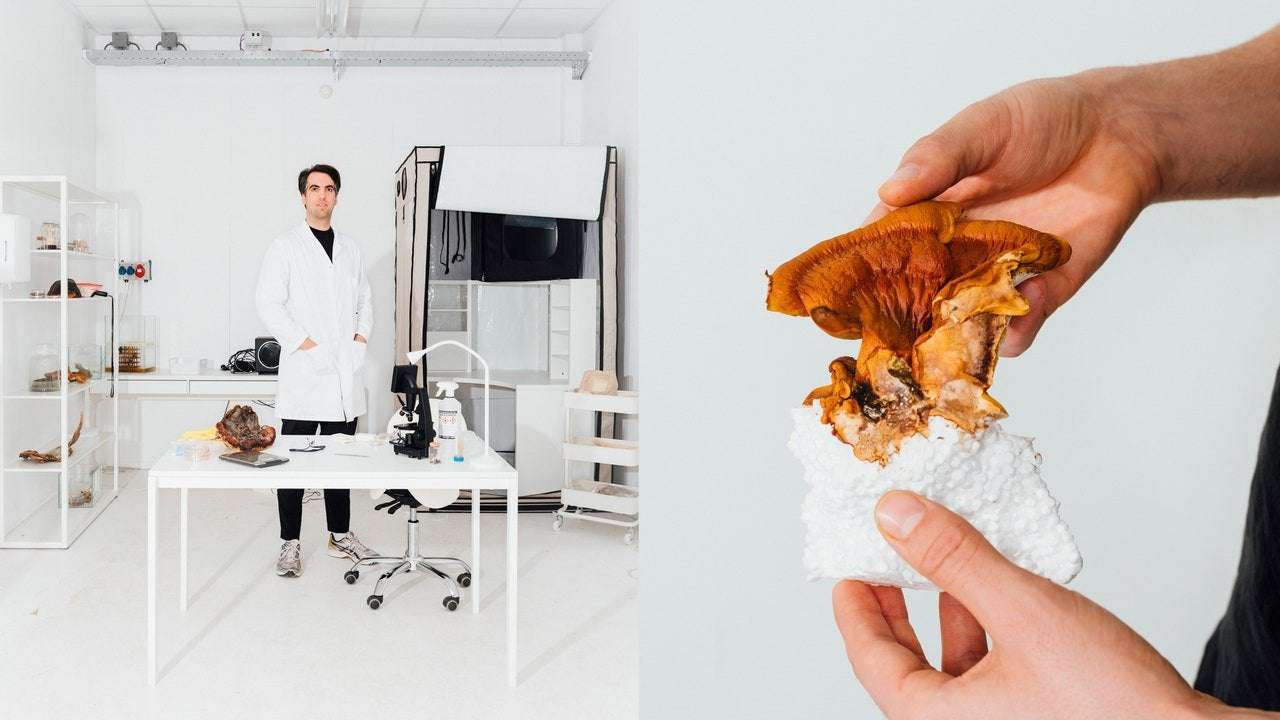DUTCH STARTUP LOOP runs a factory in the city of Delft that’s unlike any other you may have visited. For one thing, as soon as you enter, the scent of mushrooms fills your nostrils like the smell of a forest after rain. If you follow your nose, you’ll arrive at a damp former vehicle repair workshop, filled with industrial-size fridges, heaters, fans, and two greenhouses. White lab coats and glassware are dotted around, and in one corner sit 25 yellowish-white caskets the color of a poorly maintained incisor, racked up and ready to go. Each is around the size and width of a fully grown man, and subtly different in color and texture, like Styrofoam with a soft, velvety outer coating. This is the production line for a living box in which to bury dead people.
On any other given work day, there would have been a dozen staff members busily bustling around the place, but the factory was closed on the cold October afternoon I visited, so Loop’s founder, Bob Hendrikx, a 27-year-old with a long, boyish face and wavy dark brown hair, showed me around. “The weather conditions outside make a lot of difference,” Hendrikx says, explaining the manufacturing process. “One degree off and you have a different product.”
Loop is a design company conceived around the simple idea of solving everyday problems by harnessing the unique attributes of living organisms. Its first product, the Living Cocoon, is a funeral casket made from mycelium, the tangle of microscopic filaments that exists underneath a mushroom. If the mushroom is the fruiting body (think apples or oranges), the mycelium is the rest of the tree: roots, branches, and all.
When mushrooms reproduce, they release airborne spores that, when they land on a substrate in a suitable environment, produce cylindrical white filaments known as hyphae. As these grow and branch they create webs of hyphae called mycelium. The mushroom you see above ground is only a tiny part of the organism; the rest extends rootlike below ground, spreading out in every direction. Given time, resources, and optimal conditions, mycelium can become vast. The largest on record, a specimen of Armillaria ostoyae discovered in Oregon in 1998, covers a total of 2,384 acres, making it the largest living organism in the world.
Mycelium is nature’s great recycler. As they feed, hyphae release enzymes that are able to convert organic compounds like wood and leaves, but also human-made pollutants—including pesticides, hydrocarbons, and chlorinated compounds—into soluble nutrients. As such, mycelia have been deployed to clean up oil spills and chemical contaminants. Myco-remediation, as the method is called, has been used by the US military to clear up neurotoxins, and to clean asbestos and Japanese knotweed found in London’s Queen Elizabeth Olympic Park before the 2012 games.

SlackerKey on August 24th, 2022 at 03:41 UTC »
I love the idea of being useful as compost. My standing will is that I want to be eaten by cats.
explodedsun on August 24th, 2022 at 02:16 UTC »
Sounds like a threat.
TASTY_TASTY_WAFFLES on August 24th, 2022 at 00:16 UTC »
When I'm dead just throw me in the trash